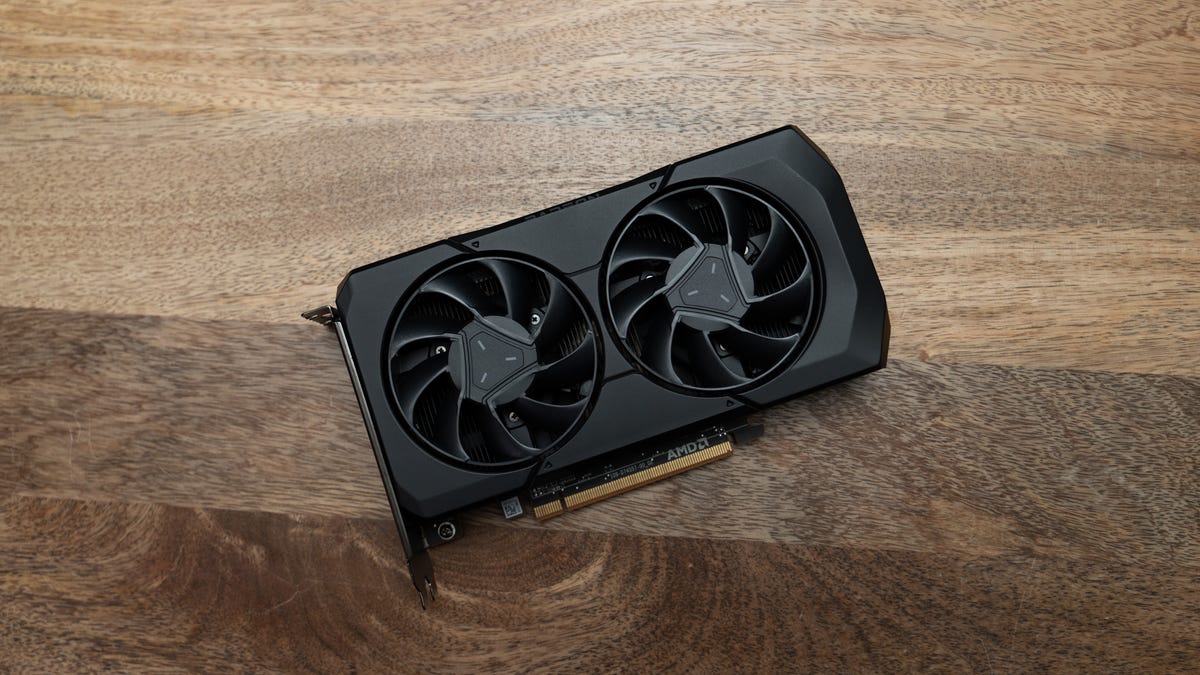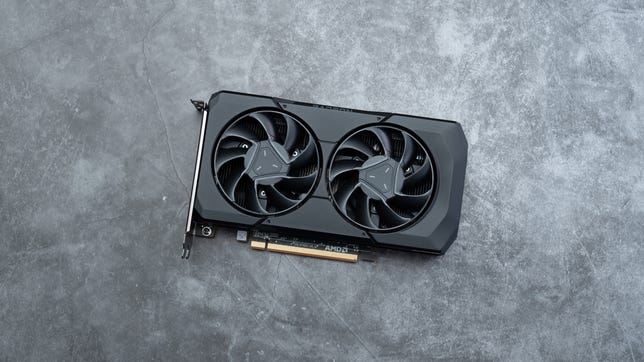 Why You Can Trust CNET
Why You Can Trust CNET AMD Radeon RX 7600 Review: A Good 1080p Gaming Value, With Caveats
Small, relatively inexpensive and with solid performance, the RX 7600 can fit nicely into your budget gaming PC.

It seems like graphics card prices are dropping daily, especially for the budget 1080p gaming end of the market: No sooner had Nvidia announced its RTX 4060 at $300 when Intel decreased the price of its competing Arc A750 by about $70 to $200. And shortly before AMD even announced its new Radeon RX 7600, the company reacted to Nvidia's pricing by shaving $30 off it to come in at a starting price of $270.
These types of recalibrations in prices aren't unusual -- it's an "Uh oh. We don't think our card will perform as well for the same money" response. It's actually quite refreshing, a return to normal after the years of cryptomining- and pandemic-driven price insanity. And $269 feels about where this card should fall, delivering solid 1080p frame rates. But if you've got any interest in taking quality up a notch with raytracing or growing into 1440p, it may fall a bit short. And at $200, the Arc A750 looks surprisingly attractive in comparison.

AMD Radeon RX 7600
Like
- Compact and suitable for budget gaming PCs and upgrades
- Solid 1080p performance for the money
Don't like
- Some minor wonkiness
- AMD's raytracing performance still not up to par
You'll be able to buy the RX 7600 starting this week; there's an AMD version (which we tested) as well as versions from its usual board partners, such as ASRock, Asus, MSI, Gigabyte, PowerColor and more.
It's not the cheapest AMD option, just the cheapest one based on AMD's current RDNA 3 architecture. The last-gen RDNA 2 models, RX 6600 and 6650 XT remain in the line starting as low as $229. Above the RX 7600, there are no RX 7800 or RX 7700-class models as yet, so above the RX 7600 are the older 12GB 6700 XT and 6750 XT and the 16GB RX 6800, 6800 XT and 6950 XT, covering a price range from about $370 to about $900.
With 8GB of VRAM, small size -- it's two slots wide, but it's quite short at under 9 inches -- and relatively modest power and slot requirements, it's a perfect fit for a new budget gaming PC build or for upgrading a 3-year-old low-end GPU in an older system.
AMD Radeon RX 7600
| Memory | 8GB GDDR6 |
|---|---|
| Memory bandwidth (GBps) | 287 |
| Memory clock (GHz) | 2.248 |
| GPU clock (GHz, game/boost) | 2.250/2.625 |
| Memory data rate/Interface | 18Gbps/128 bits |
| Ray accelerators | 32 |
| Stream processors | 2,048 |
| Texture mapping units | n/a |
| Compute Units | 32 |
| AI accelerators | 64 |
| Process | 6nm |
| Total board power (watts) | 165 |
| Max thermal (degrees) | n/a |
| Bus | PCIe 4.0x8 |
| Size | 2 slots |
| Launch price | $270 |
| Ship date | May 25, 2023 |
Unlike Nvidia, all of AMDs graphics cards have DisplayPort 2.1 connectors (Nvidia's still on 1.4a), but its somewhat moot for this class of GPU -- it doesn't have enough power to require the extra bandwidth that connection affords, like running 4K at high refresh rates.
Performance
In testing, the card generally delivered 1080p in the 80 to 120fps range at high quality depending upon the game, but you'll have to scale back quality if you want to jump to 1440p.
The company's FidelityFX Super Resolution 2.0 technology for upscaling theoretically offers a substantial performance bump: On the new 3DMark FSR 2 test, it boosted frame rates at least 75% and up to 190% with a variety of settings. (I didn't test every permutation of resolution and quality because testing is an abyss I may never crawl out of.) But in many cases that just boosted 1440p frame rates from unplayable to borderline.
There aren't a lot of games with FSR 2/2.1 -- just about 50 at my last count, some of which haven't shipped yet -- and I wasn't really happy with earlier versions. Still need to do more testing on this, especially versus Nvidia's DLSS 3 and Intel's XeSS. Data accumulation in progress.
Like its siblings, the RX 7600 has three DisplayPort 2.1 connections and one HDMI 2.1.
The automatic overclocking of the GPU and memory via the driver didn't seem to have much of an effect, though it remained stable in stress tests; you can manually tune them, but see above regarding testing abyss.
But one thing I consistently see is subpar raytracing performance compared with other GPUs. AMD seems to lag Nvidia and even relative newcomer Intel by a generation, even with the higher end RX 7900 XTX and XT. However, raytracing isn't a hugely popular feature priority compared with the desire for better performance at higher resolutions; if you fall into that camp, don't sweat it.
AMD does seem to excel at certain types of pro graphics tasks, notably those represented by the types of applications SpecViewPerf tests. It's not exceptionally fast (it is a low end card, after all) and only at about 1440p and below, but for the money it seems like a good value.
I did experience a few screen redraw glitches and one system hang, but I couldn't isolate the causes or replicate them, so for the moment I'll consider them rub of the green.
I wouldn't be surprised if we saw more new models to replace AMD's existing 6000-series cards around the same time as Nvidia ships the RTX 4060 -- July -- and unless your current GPU is making you crazy with the slow, I'd wait to see what AMD's planning and how the RTX 4060 shapes up.
Relative performance of other GPUs
Shadow of the Tomb Raider gaming test (1440p)
3DMark Time Spy graphics test
3DMark Fire Strike Ultra
Guardians of the Galaxy (1080p at maximum quality with ray tracing)
3DMark Speed Way (DX12 Ultimate)
3DMark DXR (DirectX Ray Tracing)
SpecViewPerf 2020 SolidWorks (1080p)
Test PC configuration
| Custom PC | Microsoft Windows 11 Pro (22H2); 3.2GHz Intel Core i9-12900K; 32GB DDR5-4800; 2x Corsair MP600 Pro SSD; Corsair HX1200 80 Plus Platinum PSU, MSI MPG Z690 Force Wi-Fi motherboard, Corsair 4000D Airflow midtower case |
|---|

